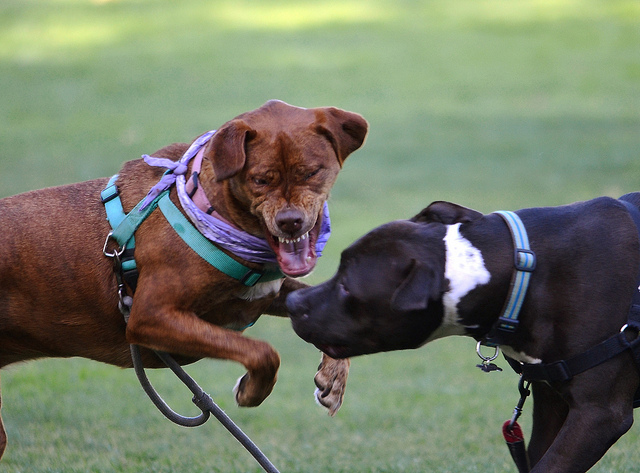 In our Part I article on “Dog Behavior Problems – What Are They?“, we explained the need for gathering valuable information from a number of different places to help determine the possible root cause of problem behaviors. Those places included, the dog’s environment (environmental), his relationship with his family (social), and any possible genetic predispositions (biological) the dog may have to specific behavior problems. Although these areas may not represent all of the possible factors involved, they do provide a very good starting point for determining what the overall issues are.
In our Part I article on “Dog Behavior Problems – What Are They?“, we explained the need for gathering valuable information from a number of different places to help determine the possible root cause of problem behaviors. Those places included, the dog’s environment (environmental), his relationship with his family (social), and any possible genetic predispositions (biological) the dog may have to specific behavior problems. Although these areas may not represent all of the possible factors involved, they do provide a very good starting point for determining what the overall issues are.
In this article, we’ll continue the discussion of problem solving by using a training framework to help incorporate the information gathered in your environmental, biological and social assessment to create a treatment plan, which is tailored specifically to your dog’s unique situation.
Dog Behavior Problems – Framework Components
T – Train and Reward Acceptable Alternatives
E – Eliminate Possible Triggers
A – Associate Positive Things
C– Consequences
H – Help by Understanding
M – Manage Dog’s Environment
E – Everybody “Teaches” All the Time
As you can see from the list above, the acronym “Teach Me” can be used to help remember the different framework components.
Whenever you need some help in working through a difficult situation with your dog, just use the “Teach Me” framework. Step through each component and try to apply each of the concepts to your situation to identify a possible workable solution for you and your dog.
“Note that there are concepts contained withing each component that may overlap into other components.”
We’ll now describe each component and provide examples of how they might be applied to various problem solving situations.
T – Train and Reward Acceptable Alternatives
Most dog behavior problems that are deemed “problem” behavior by owners are actually normal “acceptable” behaviors to our canine companions. Activities such as barking, chewing, jumping, nipping, etc. are all very typical, enjoyable behaviors to our dogs. The more the dog is able to engage in these behaviors, the more he will enjoy them, and consequently perform them in the future.
Your goal is to try and reward acceptable alternative behaviors to replace the problematic ones. Being proactive can help in this regard.
Whenever, you see your dog doing something you really approve of, reward him for it. It can be anything the dog really considers rewarding. Let the dog know how much you appreciate the fact that he is doing something you really like. Don’t fall into the trap of only paying attention to your dog when he’s doing something wrong.
If the actual underlying cause of your dog’s behavior problems are attention-seeking behaviors, he will quickly learn that bad behavior is the quickest way to get him attention, and you will be rewarding the very behaviors you are trying to stop.
Here are some other examples of teaching acceptable alternative behaviors:
- Instead of problem jumping, teach him that sitting gets him the most rewards
- Instead of problem chewing, teach him that chewing on proper chew toys gets him extra praise and other rewards
- Instead of running around the house before a walk, teach him that sitting gets his leash put on faster
“Always try to think of better ways for your dog to get the rewards he’s looking for.”
E – Eliminate Possible Causes
Determining and eliminating possible environmental triggers is critical for solving dog behavior problems. You may not get a full understanding as to why a dog may behave in a given circumstance; however sometimes just being able to identify and eliminate an obvious trigger is all that is needed when dealing with problem behaviors.
Look for obvious clues and if possible, try to keep the solutions simple. Again, sometimes an abrupt, permanent removal from a stressful situation is all that’s needed. Conversely, the problem may resurface again with another trigger, which means, you really haven’t solved the problem.
If that’s the case, continue to look for other clues that may be causing the problem behavior. Sometimes the answer isn’t so obvious, and you’ll need to uncover several layers until you get to the actual cause.
Some examples of eliminating possible triggers:
- Dog barks whenever somebody walks by the house. Try methods to obstruct his view while using alternative training methods from the “T” component above. Move him away from viewing areas.
- Dog constantly runs through house from room to room. Ensure dog is getting enough physical and mental exercise. Try challenging him with mentally stimulating toys and puzzles.
A – Associate Positive Things
Dogs that have been severely frightened, attacked, or abused can develop long-lasting behavior problems. In fact, if these events are extremely severe, or occur very early on in a dog’s development, the fearful or aggressive behaviors can stay with the dog his or her entire lifetime.
“Therefore, it’s imperative that young puppies are properly socialized and have a positive mindset to all of the world’s sights and sounds.”
What we are looking to accomplish in this component is to associate a more postive attitude towards events or objects that have been previously thought of as negative in the past. The actual term for this is called Counter Conditioning.
The goal of Counter Conditioning is changing the dog’s mindset of a previously negative event to a more positive one by suc cessive pairings of an extremely high-valued reward (pieces of juicy steak, favorite toy, chance to go for a walk) to that negative event.
cessive pairings of an extremely high-valued reward (pieces of juicy steak, favorite toy, chance to go for a walk) to that negative event.
Whenever the dog is exposed to the problematic stimulus, instead of him focusing on it and sensing something bad, his attention is directed towards the reward, which causes him to change his overall mindset of the situation, and begin to sense something good. There is no timetable for how long this can take, and depending on the nature of problem and the dog, it may not be effective for every dog and every situation.
Some examples are:
- Dog is scared of the vacuum cleaner. Give him some nice tasty treats while showing him the vacuum. Build up his tolerance little by little. Work up to being able to run the vacuum while giving him the rewards.
- Dog is frightened of other dogs on his normal walk. Have his favorite toy with and surprise him with it when he sees anything that frightens him.
C – Consequences
Consequences teach the dog that behaviors he is engaging in cost him the chance of reward. They are used to reduce the likelihood of the dog engaging in a particular behavior again the future. One important point regarding the use of consequences, is that they are to be used in conjunction with the other components of the framework. The use of negative consequences alone is not recommended.
Ideally, you’d like the dog to tie the consequences to his own actions rather than equating the consequence with you, the owner. This way he won’t equate you having to be around him in order for the consequences to occur. It’s best if he realizes that, no matter where you are, if he acts inappropriately, negative things can occur.
Again, the use of consequences should be used in addition to the other concepts included in this framework. Relying solely on the uses of consequences and punishment alone can have negative effects on behavior. If the consequences you are using do not solve the problem, you should stop using them and look for alternative methods.
Each use of a consequence should stop the problem behavior within a few applications. They must be based on the individual drives and thresholds of the dog(s) they are being administered to.
Some examples of consequences are:
- Every time the dog begins chewing a on something inappropriate, a spray of chewing deterrent is sprayed on their tongue
- Every time the dog jumps up, the person she jumps on turns away and moves from the dog until she sits nicely.
H – Help by Understanding
In part I, we talked about owners labeling behaviors as problems without having a fair understanding of normal canine behaviors. Sometimes problem behaviors may be viewed as less of a problem, or possibly not as problems at all once owners have a better understanding of why a dog may be behaving in a particular way.
Also, another concept that can often help problem behavior situations is compromising. Both you and your dog give a little and meet comfortably in the middle. Each of you gets a portion of what you had originally wanted, and there is no further strain on the relationship. This dovetails nicely with the “T” component.
Examples of Helpful Understanding are:
- The dog has a great deal of stored-up energy, which causes problems. Instead of one walk a day, you take him for 2 longer walks.
- Instead of digging holes all over the yard, you build an acceptable digging pit for him.
M – Manage the Dog’s Environment
This component, along with “Eliminating the Trigger” is all about being proactive. The idea here is to create a situation for the dog so that he has no choice but to make the correct decision and offer the proper behavior. Until the dog can be trusted to behave properly in a given situation, he must be prevented from engaging in the problem behavior, whether the owner is around or not.
This is a key component. One in which will allow all the other components to work properly. The dog must be prevented from engaging in any self-rewarding, inappropriate behaviors or they may never become unlearned. Create a situation where the dog has no choice but be successful.
Some examples are:
- Using a crate to protect the dog and your home when you’re away.
- Using baby gates to section off areas of the house the dog cannot be trusted in without supervision
- Keeping the dog on a leash when greeting new people so he isn’t allowed to jump.
E – Everyone “Teaches” All of the Time
This last component is the most crucial of all and it has to do with consistency. Being consistent is the glue that holds the entire framework together. Once a treatment plan is in place, it’s success fully depends on the cooperation of everyone that will come into contact with the dog. Everybody must follow the plan you’ve designed 100% of the time.
Inconsistencies teach the dog that he can be rewarded for misbehaving at certains times, while at other times, he’s faced with unpleasant consequences. It creates a situation where the dog is unsure of his family and his environment, which can cause other problems.
“Dogs are happiest when they know what is expected of them. They feel safe and secure where the rules are known and everything is consistent.”
To summarize, each component of the training framework works together to allow for an organized and comprehensive approach to help dealing with even the most difficult dog behavior problems. Even though there is no guarantee that every problem behavior can be solved, this framework will provide you with the tools necessary to, at a minimum, manage and deal with the situation more positively and effectively.
Note: If you are concerned about your safety or the safety of anyone whom may come into contact with your dog due to severe dog behavior problems, you should contact your veterinarian or a certified animal behaviorist immediately.














